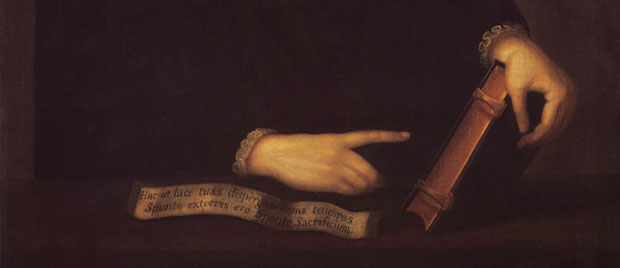William Tyndale’s Portrait

Featured prominently in my study, as though looking over my right shoulder, is a reproduction of a stunning portrait of the great Bible translator William Tyndale. Painted in oil on canvas, the original work is from the brush of an unknown artist. It was produced in the late seventeenth or early eighteenth century and now hangs in the National Portrait Gallery in London. As the subject of the portrait, Tyndale is seated, dressed all in black, and surrounded by a subdued dark-brown background. His face and hands seem to glow from the light of a candle that is hidden from view.
Tyndale’s left hand is balancing a book, keeping it horizontal lest it fall. This book is a Bible, the collection of divinely inspired writings that Tyndale devoted his life to translating from the Hebrew and Greek into English. His right hand appears to be resting on a dark table, while his right index finger is pointing emphatically to the Bible. Tyndale is directing the observer’s attention away from himself, and instead drawing every eye toward this sacred Book in which he resolutely believed and to which he dedicated his whole life.
Beneath the Bible, the artist has painted an unfurled banner, seemingly suspended in air. Signifying Tyndale as an Oxford and Cambridge scholar, the writing on the banner is in Latin: Hac ut luce tuas dispergam Roma tenebras sponte extorris ero sponte sacrificium. This means, "To scatter Roman darkness by this light, the loss of land and life I will reckon slight." This bold message represents the life’s mission of Tyndale. By translating the Bible into English, this brilliant linguist ignited the flame that would banish the spiritual darkness in England. Tyndale’s translation of the Scriptures unveiled the divine light of biblical truth that would shine across the English-speaking world, ushering in the dawning of a new day.
In the background of this portrait, behind Tyndale, are the words Gulielmus Tindilus Martyr. This is the Latin rendering of this scholar's first and last name, along with the word martyr, which identifies the high cost paid by Tyndale to bring the Scriptures into the language of his countrymen. This heroic figure died a martyr’s death in 1536, strangled to death by an iron chain, after which his corpse was burned and blown up by gunpowder that had been spread around his incinerated body. At the bottom of the portrait, there is a panel giving the explanation of Tyndale’s martyrdom. The words are in Latin and translate as follows:
This picture represents, as far as art could, William Tyndale, sometime student of this Hall [Magdalen] and its ornament, who after establishing here the happy beginnings of a purer theology, at Antwerp devoted his energies to translating into the vernacular the New Testament and the Pentateuch, a labour so greatly tending to the salvation of his fellow-countrymen that he was rightly called the Apostle of England. He gained his martyr’s crown at Vilvoorde near Brussels in 1536, a man, if we may believe even his adversary (the Emperor’s Procurator General), learned, pious, and good.
The irony of this portrait is that Tyndale never sat for such a rendering. To protect his anonymity, he could not have his facial likeness reproduced onto canvas. The work he carried out came at too high a price to allow himself to be recognized. Only after his gruesome death could Tyndale be known.
This portrait of Tyndale hangs in my study as a constant visual reminder of the invaluable treasure that sits on my desk: the English Bible. It underscores the fact that as I preach its truths, spiritual light is being sent forth into this dark world. Moreover, this portrait bears witness to me of the great price required to unveil its truth in this sin-blackened age.
This article is part of The Daring Mission of William Tyndale collection.